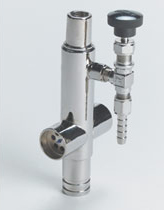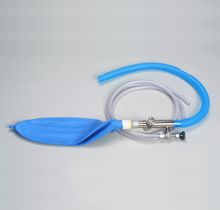This
device installs between the anesthesia machine and the vacuum evacuation
system. It equalizes both positive and negative pressure such that no
metabolic gases are pulled past the patient.
| |
 |
 |
Scavenging Interface Valve
Item Number:
931439 |
Scavenging
Interface Kit
Includes:
3L reservoir bag, 6 each of 1/4" ID suction hose
and 19mm evacuation tubing.
Item Number: 931440 |
| |
Resevoir
Bags
3.0 Liter Breathing Bag
For
use with scavenging interface valves equipped with a standard 19mm
bag hanger.
Item Number: 921405 |
| |
NIOSH recommendation
to OSHA:
" Workers
should not be exposed to an eight hour time-weighted average of > 2
ppm halogenated agents."
Excerpts from
OSHA Directorate for Technical Support; Science and Technical Assessment,
7/20/99 - Revised 5/18/00:
" Removal
of excess anesthetic gases from the anesthesia circuit can be accomplished
by either active or passive scavenging.
• When a vacuum
or source of negative pressure is connected to the scavenging interface,
the system is described as active.
• When a vacuum
or negative pressure is not used, the system is described as passive.
The scavenging interface
serves to prevent potentially dangerous increases or decreases of pressure
in the anesthetic waste gas disposal system from reaching the patient's
breathing circuit. To do this, the interface has three components: positive
pressure relief, negative pressure relief, and a reservoir.
Regardless of the
type of disposal system used (i.e., active or passive), positive pressure
relief must be provided to protect the equipment and patient if occlusion
of the scavenging system outlet occurs. If the scavenging system outlet
becomes occluded, the positive-pressure relief vent opens to prevent transmission
of high pressure to the breathing circuit.
If an active disposal system is used, negative pressure relief is needed
to prevent negative pressure (suction) generated by the disposal system
from reaching the patient's breathing circuit.
A reservoir is necessary
to allow the scavenging system to accommodate an increased volume of excess
anesthetic gas, which may transiently exceed the per-minute removal capacity
of the system. It may also serve as a monitor of the scavenging system
if the reservoir is a distensible bag. Overdistension of the bag could
indicate inadequate function of the system and the need to adjust the
needle valve to allow more gas to flow through."
| 
